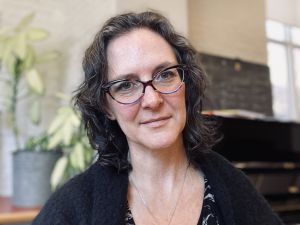 Assistant Professor of Health Sciences Rebecca MacPherson was awarded a grant from the Canada Foundation for Innovation’s John R. Evans Leaders Fund (JELF) to purchase equipment for her research on the interactions between metabolism, diet and exercise.
Assistant Professor of Health Sciences Rebecca MacPherson was awarded a grant from the Canada Foundation for Innovation’s John R. Evans Leaders Fund (JELF) to purchase equipment for her research on the interactions between metabolism, diet and exercise.It’s a common notion that people seem to become more forgetful as they get older, leading many to conclude that memory declines with age.
But Brock University Assistant Professor of Psychology Karen Campbell aims to counteract that view by showing that something else is happening in the brain that mimics memory loss.
Meanwhile, Assistant Professor of Health Sciences Rebecca MacPherson is concerned about rising rates of obesity and how diet and exercise — or lack thereof — affects people as they age.
To aid in their investigations, MacPherson and Campbell will be purchasing state-of-the-art equipment thanks to funding from the Canada Foundation for Innovation’s John R. Evans Leaders Fund (JELF).
On Wednesday, March 13, Federal Minister of Science and Sport Kirsty Duncan announced JELF grants of more than $39 million at 43 universities across Canada. Brock University received $241,708 for the equipment purchase.

Canada Research Chair in Cognitive Neuroscience of Aging and Assistant Professor of Psychology Karen Campbell examines brain scans as part of her research on
age differences in attentional control. She was awarded a grant from the Canada Foundation for Innovation’s John R. Evans Leaders Fund (JELF) to purchase equipment for this research.
“The Canada Foundation for Innovation’s John R. Evans Leaders Fund has been giving excellent support for Brock’s cutting-edge research over the years,” says Tim Kenyon, Brock University’s Vice-President, Research.
“These latest awards will open up new understandings in two key areas of great significance to society: what underpins age differences in memory; and the mechanisms of obesity and related diseases.”
Campbell, Canada Research Chair in Cognitive Neuroscience of Aging, challenges conventional laboratory tasks that test older participants’ ability to remember things or make new associations, such as pairing a name with a face.
Her research shows that age differences in attentional control — the ability to focus on relevant information and block out distraction — may be at the heart of what looks like memory loss.
“Older adults pick up on more distracting information than younger adults, and this can both help and hinder their memory performance on a later task, depending on the nature of the task,” says Campbell.
She will be acquiring an electroencephalography (EEG) system and an eye tracker to study, among other research goals, how this distracting information is encoded in the brain and whether it affects memory for events in everyday life.
“Canada’s population is getting older and we still don’t know very much about how the mind and brain change with age,” says Campbell. “This equipment will also allow us to study some of the modifiable lifestyle factors, such as sleep and exercise, that contribute to healthy aging.”
For her part, MacPherson warns of the approaching “silver tsunami,” where a quarter of the population will be 65 years and older by 2036.
“The current increase in life expectancy and our ever-expanding waistline goes hand in hand with the emergence of common age-related chronic diseases,” she says.
To better understand the interactions between metabolism, diet and exercise, and what causes metabolism disturbances that lead to disorders like obesity, Type 2 diabetes and Alzheimer’s disease, MacPherson will be studying rodent physiology.
She will purchase equipment that measures rodents’ activity levels, food and water intake, how much oxygen they take up and the level of carbon dioxide they expel. Researchers want to know if measures such as changing the fat type or content of their diet, installing exercise wheels in cages or using dietary supplements will affect their metabolic rate.
“The studies would give us an idea of whether any of these treatments or interventions would potentially work in humans,” says MacPherson, explaining that animal and human physiologies are similar enough to make such comparisons.
The John R. Evans Leaders Fund enables a select number of an institution’s excellent researchers to conduct cutting-edge research by supplying the equipment and infrastructure they need to become leaders in their field.
“In turn, this enables institutions to remain internationally competitive in areas of research and technology development, aligned with their strategic priorities,” says the JELF site.









